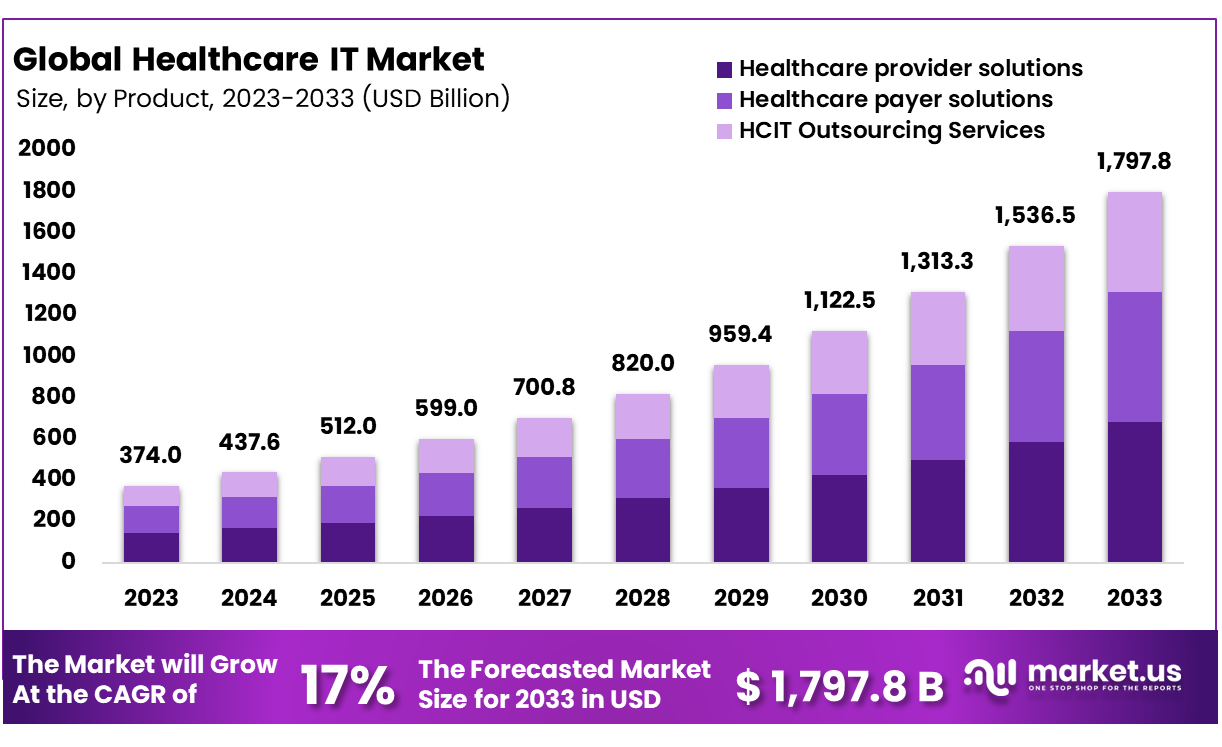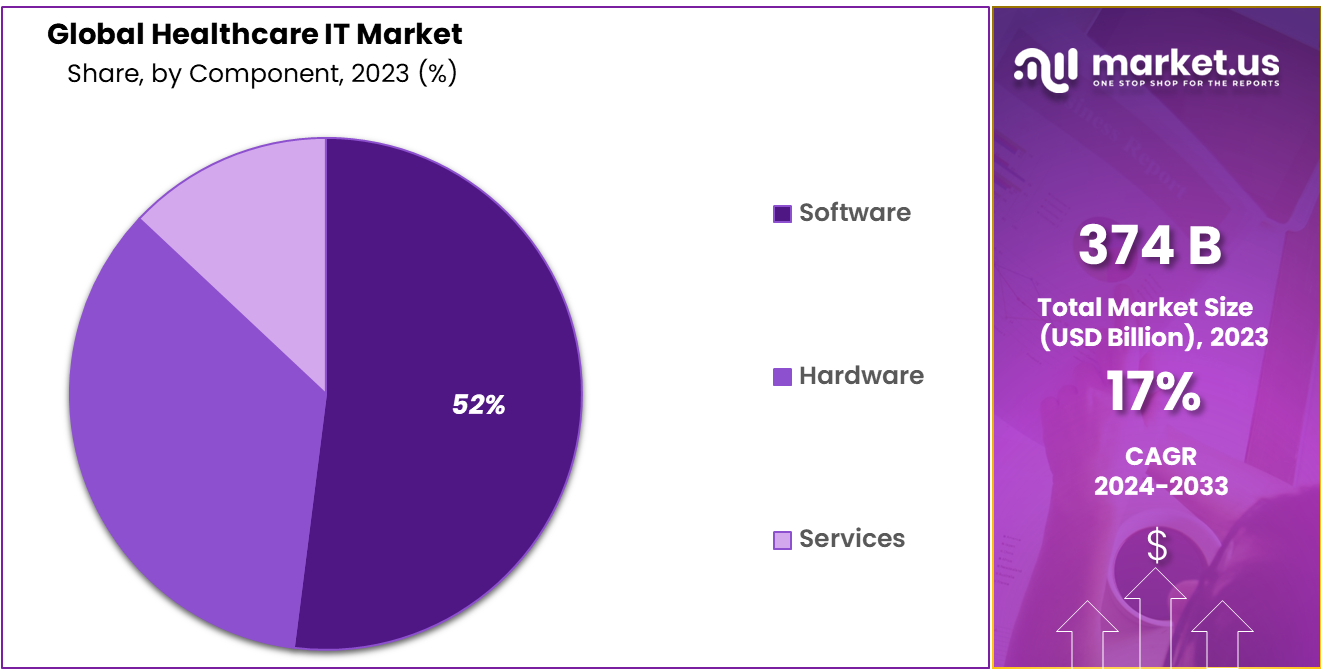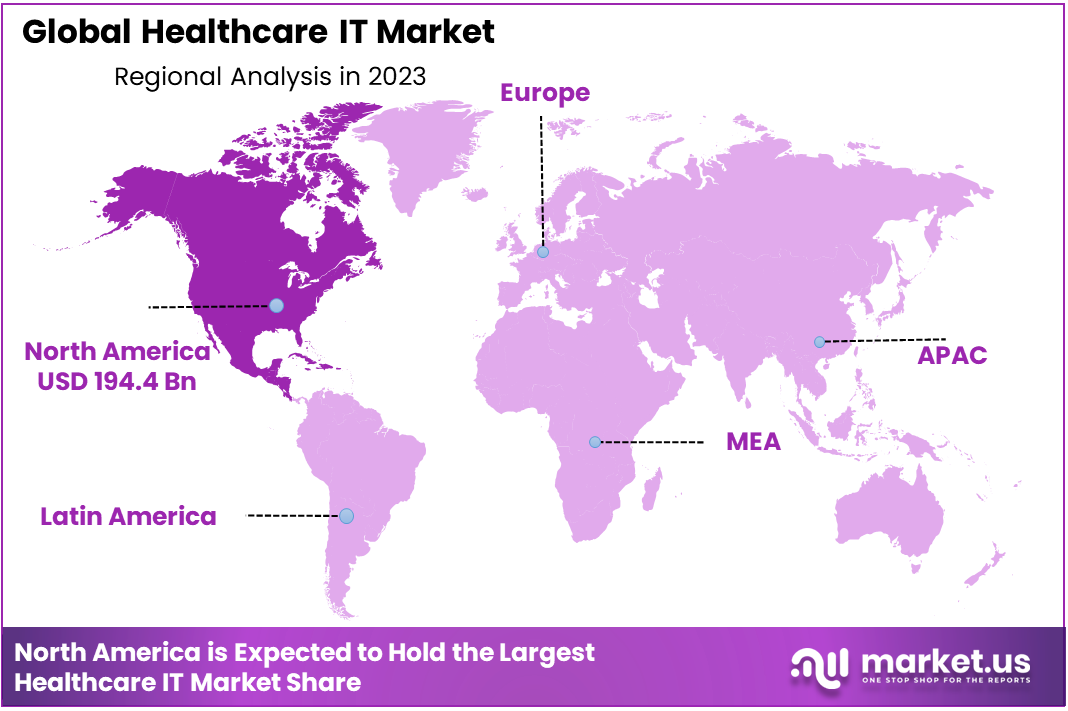Global Healthcare IT Market By Product Type (Healthcare Provider Solutions, Healthcare Payer Solutions, and HCIT Outsourcing Services), By Component (Software, Hardware, and Services), By Deployment Mode (On-premise and Cloud-based), By End-User (Healthcare Providers and Healthcare Payer), By Region and Companies - Industry Segment Outlook, Market Assessment, Competition Scenario, Trends, and Forecast 2024-2033
- Published date: Jan 2024
- Report ID: 101978
- Number of Pages: 352
- Format:
- keyboard_arrow_up
Quick Navigation
Report Overview
The Global Healthcare IT Market size is expected to be worth around USD 1797.8 Billion by 2033 from USD 374.0 Billion in 2023, growing at a CAGR of 17% during the forecast period from 2024 to 2033.
Healthcare IT studies information technology and its vast applications in the healthcare industry to enhance profit potential and make better decisions. Clinical informatics is used in large-scale healthcare settings, including the military, hospitals, and research institutes. The surge in acceptance of mHealth and telehealth solutions, rise in demand for quality healthcare solutions and services and rise in government initiatives to promote HCIT and improve patient health and safety all the above factors boost the market’s growth globally.
Also, increasing demand for preventive care solutions, enhancing the trend of digitalization in healthcare, increasing partnerships & funding, and growth of different entrepreneurship ventures are enhancing the healthcare IT market.

Key Takeaways
- Market Overview: The global healthcare IT market is expected to reach USD 1,797.8 billion by 2033, with a CAGR of 17% from 2024 to 2033. Healthcare IT encompasses the use of information technology in healthcare settings to improve decision-making and profitability.
- Product Type Analysis: Healthcare provider solutions dominate the market with a 38% revenue share, driven by the adoption of electronic health records (EHR) and cloud technology.
- Component Analysis: Healthcare IT services hold the largest market share at 52%, offering services like cybersecurity and online payment solutions. On-premise deployment is moderate due to data security concerns, but it is considered more secure.
- End-User Analysis: Healthcare payers are expected to generate the highest revenue, with private payers partnering with Medicaid/Medicare agencies to provide electronic health information infrastructure.
- Drivers: Major players are developing advanced healthcare IT platforms, enhancing market growth. Rising disposable income enables more people to afford healthcare IT services.
- Restraints: Data invasion and privacy concerns, along with cybersecurity risks, hinder market growth.
- Opportunities: Increasing demand for information technology in healthcare, driven by digitalization tools like telehealth and AI. Government initiatives, like India’s Pradhan Mantri Digital Health Mission, support digital health, contributing to market growth.
- Trends: Value-based payment models and Accountable Care Organizations (ACOs) are driving partnerships and mergers between payers and providers. COVID-19 had a positive impact on the market, boosting demand for digital healthcare solutions and online consultations.
- Regional Analysis: North America dominates the market with a 52% revenue share, driven by digital literacy and infrastructure. Europe is projected to have the fastest growth due to government support and AI adoption.
- Key Players: Major players include GE Healthcare Technologies, Philips, eClinicalWorks, Carestream Health, McKesson Corporation, and others.
Product Type Analysis
Healthcare Provider Solutions Have Dominated the segment
Healthcare provider solutions dominated the market with the highest revenue share of 38%. The reason behind the dominance of the segment was the increasing implementation of electronic health records (EHR) and other hospital information systems by healthcare providers. In addition, the market is estimated to experience considerable growth due to increased demand for quality healthcare services and solutions, the adoption of cloud technology in healthcare, and other factors.
Component Analysis
The Services Segment Accounted for a Significant Revenue Share
Cybersecurity, network and hardware management, on-site and cloud backups, and other services come under healthcare IT services. The services segment held the largest market share at 52%. Healthcare IT supported hospitals, medical billing businesses, and even physician groups. Also, introducing online payment services boosts the market’s revenue share. In addition, extending financial responsibilities and expanding high-deductible health plans are increasing the demand for these services.
Deployment Mode Analysis
The On-premise Segment accounted for a Moderate Growth
The on-premise held 71.3% share of the healthcare IT market because of the reduced risk of a data breach. The on-premise infrastructure is usually stored on-site. For security reasons, extra sensitive data should preferably be kept on-premises. The on-premise software is managed by the customer, who oversees its availability, general administration, and security.
This software is more expensive than cloud-based software as the capital expenditures for software licenses are quite high. Additionally, on-premise software is considered more secure because the full instance of software stays on the organization’s ground.
End-User Analysis
The Healthcare Payer Segment is Estimated to be the Largest Growing Segment
The healthcare payer segment is accounted 63.2% share in the market. Private payers are extensively partnering with Medicaid or Medicare agencies to offer integrated and secure electronic health information infrastructure to healthcare professionals, patients, and facilities. Thus, it propels the growth of the market.

Key Market Segments
Based on Product Type
- Healthcare Provider Solutions
- Healthcare Payer Solutions
- HCIT Outsourcing Services
Based on Component
- Software
- Hardware
- Services
Based on the Deployment Mode
- Private Payer
- Public Payer
Based on End-User
- Healthcare Providers
- Hospitals
- Diagnostic and Imaging Centers
- Pharmacies
- Ambulatory Clinical Units
- Healthcare Payer
- On-premise
- Cloud-based
Drivers
Increasing Technological Advancements by Market Key Players
Major market players are developing proficient healthcare IT platforms to propel the market’s growth. For instance, a healthcare information technology company named Mednet launched software including extended ePRO (electronic patient-reported outcomes) capabilities. It is created to enable remote participation and surge patient engagement. Additionally, Medidata Solutions, Inc. was acquired by Dassault Systemes.
Restraints
Problems with Data Invasion and Privacy
Even though these consulting services are in huge demand, there is still a huge issue with data invasion. There is a continuous risk of hacking which may put the data at risk. This results in a reduction in the adoption of the solutions. Hence, it is a major factor that hindered the market’s growth.
Opportunities
Increasing Demand for Information Technology
A rise in demand for information technology enhances the global healthcare IT market growth. The high implementation rate of digitalization tools such as telehealth services, artificial intelligence, and others propel the market’s growth. These technologies help ease the workflow, improve the systems, lower the cost of services, and increase patient outcomes. All the factors mentioned above propel the growth of the market.
Increasing Rate of Government Initiatives
Governments of different nations are taking various initiatives to influence digital health, contributing to the market’s growth. For instance, the Pradhan Mantra Digital Health Mission was rolled out by the Indian Prime Minister intending to digitalize healthcare practices in the nation. The nationwide digital health ecosystem allows patients to access, store, and share health records.
Trends
Value-Based Payment Models and Accountable Care Organizations (ACOs) are Prompting the Trend
Value-based payment models and ACO are spurring the industry trends towards joint ventures, partnerships, and payer-provider mergers to address fragmented healthcare delivery, promote care coordination, and emphasize patient-centered care. Thus, it aligns the incentives and goals among providers, patients, and payers. For instance, CVS Health finished its acquisition of Aetna.
The aim is to build healthier communities and transform the health experience by offering less expensive, local care, putting customers at the center of their care, and making it easier to use. This development towards value-based reimbursement benefits all three stakeholders of the healthcare industry, including healthcare providers, payers, and patients. The value-based reimbursement inspires healthcare providers to offer the best care at a cheaper cost. Thus, the patients may get high-quality care at a superior value.
Regional Analysis
North America Dominated the Global Healthcare IT Market
North America accounted for the largest revenue share of 52% of the global healthcare IT market. This region is estimated to register the fastest growth rate over the forecast period. Improved internet connectivity, smartphone penetration, digital literacy, healthcare IT solutions, key players’ presence, and infrastructure advancements are the few factors driving the market’s growth. To improve the patient care experience and reduce healthcare costs, the NA care industry is rapidly implementing and adopting IT services, propelling the market growth.
Europe is projected to report the fastest growth rate during the forecast period. The presence of prominent market players, increased adoption of artificial intelligence, significant government support, and investment in emerging healthcare IT is a few factors responsible for the market growth in this region.

Key Regions
- North America
- The US
- Canada
- Mexico
- Western Europe
- Germany
- France
- The UK
- Spain
- Italy
- Portugal
- Ireland
- Austria
- Switzerland
- Benelux
- Nordic
- Rest of Western Europe
- Eastern Europe
- Russia
- Poland
- The Czech Republic
- Greece
- Rest of Eastern Europe
- APAC
- China
- Japan
- South Korea
- India
- Australia & New Zealand
- Indonesia
- Malaysia
- Philippines
- Singapore
- Thailand
- Vietnam
- Rest of APAC
- Latin America
- Brazil
- Colombia
- Chile
- Argentina
- Costa Rica
- Rest of Latin America
- Middle East & Africa
- Algeria
- Egypt
- Israel
- Kuwait
- Nigeria
- Saudi Arabia
- South Africa
- Turkey
- United Arab Emirates
- Rest of MEA
Key Players Analysis
Mednet Launched Software with Extended Electronic Patient Reported Outcomes Capabilities.
The global healthcare IT market is distributed among many medium and large-size players, and they account for the majority of market revenue. Key players are focusing on their mergers & acquisitions, technological collaborations, and partnerships to expand their product portfolio & business footprint and gain a competitive edge.
For instance, in 2020, a healthcare information technology company, Mednet, launched the software, including extended ePRO capabilities. Additional market players in the healthcare market are Allscripts Healthcare Solutions, Philips Healthcare, and other prominent players.
Market Key Players
- GE Healthcare Technologies Inc.
- Koninklijke Philips N.V.
- eClinicalWorks
- Carestream Health
- McKesson Corporation
- Agfa Healthcare
- Oracle Corporation
- Advantech Co., Ltd.
- Other Key Players
Recent Developments
- In May 2022- An OBGYN-specific software suite was launched by Modmed. It is an all-in-one EHR, patient engagement, practice management, image & inventory management, analytics solution, and payments that will bring practice and workflow innovation to gynecology and obstetrics.
- In September 2022- Smart Omix was launched by Sharecare. Through mobile research studies, its proprietary digital clinical research solution enables digital biomarker creation and real-world data collection. The capabilities of Smart Omix play an important role in advancing equity, data integrity, and relevance in clinical research across the healthcare continuum.
Report Scope
Report Features Description Market Value (2023) USD 374.0 Billion Forecast Revenue (2033) USD 1,797.8 Billion CAGR (2023-2033) 17% Base Year for Estimation 2023 Historic Period 2018-2022 Forecast Period 2024-2033 Report Coverage Revenue Forecast, Market Dynamics, COVID-19 Impact, Competitive Landscape, Recent Developments Segments Covered By Product Type- Healthcare Provider Solutions, Healthcare Payer Solutions, and HCIT Outsourcing Services; By Component- Software, Hardware, and Services; By Deployment Mode- On-premise and Cloud-based; and End-User- Healthcare Providers and Healthcare Payer. Regional Analysis North America – The US, Canada, & Mexico; Western Europe – Germany, France, The UK, Spain, Italy, Portugal, Ireland, Austria, Switzerland, Benelux, Nordic, & Rest of Western Europe; Eastern Europe – Russia, Poland, The Czech Republic, Greece, & Rest of Eastern Europe; APAC – China, Japan, South Korea, India, Australia & New Zealand, Indonesia, Malaysia, Philippines, Singapore, Thailand, Vietnam, & Rest of APAC; Latin America – Brazil, Colombia, Chile, Argentina, Costa Rica, & Rest of Latin America; The Middle East & Africa – Algeria, Egypt, Israel, Kuwait, Nigeria, Saudi Arabia, South Africa, Turkey, United Arab Emirates, & Rest of MEA. Competitive Landscape GE Healthcare Technologies Inc., Koninklijke Philips N.V., eClinicalWorks, Carestream Health, McKesson Corporation, Agfa Healthcare, Oracle Corporation, Advantech Co. Ltd., and Other Key Players. Customization Scope Customization for segments, region/country-level will be provided. Moreover, additional customization can be done based on the requirements. Purchase Options We have three licenses to opt for: Single User License, Multi-User License (Up to 5 Users), Corporate Use License (Unlimited User and Printable PDF) Frequently Asked Questions (FAQ)
How big is the Healthcare IT Market?The Global Healthcare IT Market size is expected to be worth around USD 1797.8 Billion by 2033 from USD 374.0 Billion in 2023
What is the Healthcare IT Market growth?The global Healthcare IT Market is expected to grow at a compound annual growth rate of 17%. From 2024 To 2033
Who are the key companies/players in the Healthcare IT Market?Some of the key players in the Healthcare IT Markets are GE Healthcare Technologies Inc., Koninklijke Philips N.V., eClinicalWorks, Carestream Health, McKesson Corporation, Agfa Healthcare, Oracle Corporation, Advantech Co. Ltd., and Other Key Players.

- GE Healthcare Technologies Inc.
- Koninklijke Philips N.V.
- eClinicalWorks
- Carestream Health
- McKesson Corporation
- Agfa Healthcare
- Oracle Corporation
- Advantech Co., Ltd.
- Other Key Players
- settingsSettings
Our Clients
| Single User $4,599 $3,499 USD / per unit save 24% | Multi User $5,999 $4,299 USD / per unit save 28% | Corporate User $7,299 $4,999 USD / per unit save 32% | |
|---|---|---|---|
| e-Access | |||
| Report Library Access | |||
| Data Set (Excel) | |||
| Company Profile Library Access | |||
| Interactive Dashboard | |||
| Free Custumization | No | up to 10 hrs work | up to 30 hrs work |
| Accessibility | 1 User | 2-5 User | Unlimited |
| Analyst Support | up to 20 hrs | up to 40 hrs | up to 50 hrs |
| Benefit | Up to 20% off on next purchase | Up to 25% off on next purchase | Up to 30% off on next purchase |
| Buy Now ($ 3,499) | Buy Now ($ 4,299) | Buy Now ($ 4,999) |












